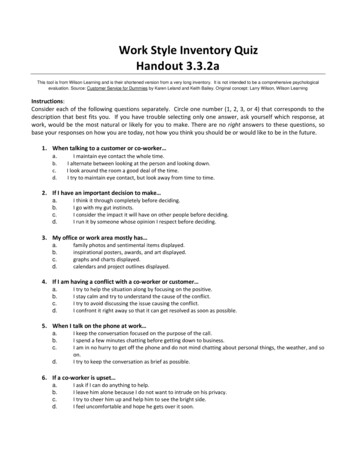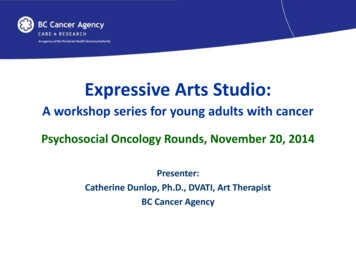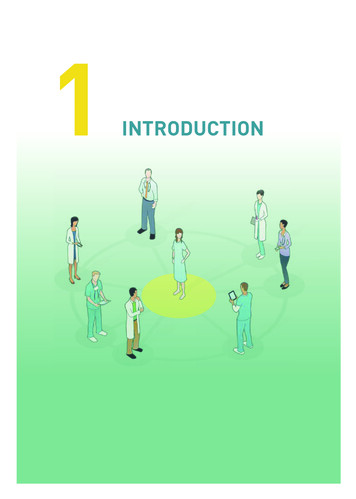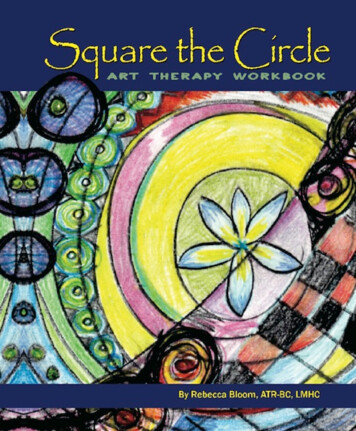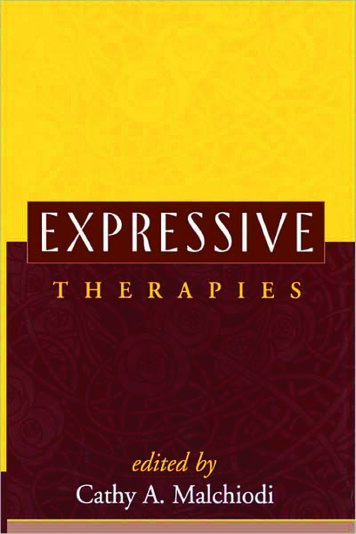
Transcription
EXPRESSIVE THERAPIES
Expressive TherapiesEdited byCATHY A. MALCHIODIForeword by Shaun McNiffTHE GUILFORD PRESSNew YorkLondon
2005 The Guilford PressA Division of Guilford Publications, Inc.72 Spring Street, New York, NY 10012www.guilford.comAll rights reservedPaperback edition 2007No part of this book may be reproduced, translated, stored ina retrieval system, or transmitted, in any form or by any means,electronic, mechanical, photocopying, microfilming, recording,or otherwise, without written permission from the Publisher.Printed in the United States of AmericaThis book is printed on acid-free paper.Last digit is print number:98765432Library of Congress Cataloging-in-Publication DataExpressive therapies / edited by Cathy A. Malchiodi ; foreword by Shaun McNiff.p. cm.Includes bibliographical references and index.ISBN-10: 1-59385-087-5 ISBN-13: 978-1-59385-087-6 (hardcover : alk. paper)ISBN-10: 1-59385-379-3 ISBN-13: 978-1-59385-379-2 (paperback)1. Arts—Therapeutic use. I. Malchiodi, Cathy A.RC489.A72E975 2005615.8 5156—dc222004019048
About the EditorAbout the EditorCathy A. Malchiodi, ATR, LPCC, CPAT, is a licensed clinical mentalhealth counselor, art therapist, and expressive arts therapist, and is also afaculty member at the National Institute for Trauma and Loss inChildren. She has more than 20 years of clinical experience in workingwith people of all ages and has worked as an art therapist with survivorsof traumatic experiences, including domestic violence, physical and sexual abuse, disaster, and serious or life-threatening illnesses. Ms. Malchiodiis a frequent presenter on art and health care throughout the UnitedStates, Canada, Asia, and Europe, and has given more than 200 invitedpresentations. She is the only person to have received all three of theAmerican Art Therapy Association’s highest honors: Distinguished Service Award (1991), Clinician Award (2000), and Honorary Life MemberAward (2002). The author or editor of numerous books, including TheArt Therapy Sourcebook, Understanding Children’s Drawings, and theHandbook of Art Therapy, she has also published over 70 peer-reviewedpapers on the use of art therapy and arts medicine with trauma survivors, survivors of child physical and sexual abuse, people with psychiatric disorders, and those with physical illness.v
ContributorsContributorsEmily DeFrance, PhD, RPT-S, is Associate Professor in the Counseling Program at Sam Houston State University in Huntsville, Texas. She has alsobeen a psychologist in private practice in Houston, Texas, for over 25 years.Dr. DeFrance has used play therapy with children of all ages, from a predominantly psychodynamic background, informed by humanistic theory.She also teaches two courses in play therapy and supervises play therapy interns through the university as well as in her private practice. She has been apresenter at the national level, and has been active in the Texas Associationfor Play Therapy as a member of the board of directors and in the Association for Play Therapy.Karen Estrella, ATR-BC, MT-BC, LMHC, has been teaching expressivetherapies at Lesley University in Cambridge, Massachusetts, since 1990. Ms.Estrella has over 20 years of experience practicing expressive therapies andmental health counseling, primarily in community-based mental health programs with a variety of clinical populations. She is also pursuing a PhD inclinical psychology at the Fielding Graduate Institute, where she integratesmore traditional approaches to psychotherapy with expressive therapy andintermodal techniques. She is writing her dissertation on issues of socialclass identity and the psychotherapy supervisor, and has a particular interestin multicultural issues in therapy. In addition to teaching, she has a privatepractice in which she does counseling and psychotherapy, expressive artstherapy, and supervision.Michele Forinash, DA, MT-BC, LMHC, is Associate Professor and coordinator of the music therapy specialization in the Division of Expressive Therapies at Lesley University in Cambridge, Massachusetts. Currently presidentvi
Contributorsviiof the American Music Therapy Association, Dr. Forinash is the editor ofMusic Therapy Supervision and coeditor of Educators, Therapists, and Artists on Reflective Practice. She has also published several articles and chapters on qualitative research in music therapy and is the North Americaneditor for the online international music therapy journal Voices: A WorldForum for Music Therapy (www.voices.no).Kenneth Gorelick, MD, RPT, a psychiatrist in private practice and ClinicalProfessor of Psychiatry at George Washington University School of Medicine, has had experience as a clinician, a teacher, and an activist. He trainedunder Arleen Hynes at St. Elizabeths Hospital, where he worked with patients coping with schizophrenia and affective illnesses. Dr. Gorelick alsoserved two terms as president of the National Association for Poetry Therapy (NAPT), was founding copresident of the NAPT Foundation, andserved many years on the board of the National Federation for Biblio/PoetryTherapy. He has given workshops nationally and internationally inRussia, Turkey, and Italy.Linda E. Homeyer, PhD, LPC, NCC, RPT-S, Associate Professor in the Professional Counseling Program at Texas State University–San Marcos, developed the play therapy training program at Texas State, including the firstplay therapy course available by distance learning. She is a frequent presenter at professional conferences and training throughout the United Statesand internationally. Dr. Homeyer is currently on the Association for PlayTherapy’s board of directors. She is coauthor of Play Therapy withChildren’s Problems, The World of Play Therapy Literature, as well as various chapters and journal articles, and coeditor (with Daniel S. Sweeney) ofThe Handbook of Group Play Therapy. She maintains a private practice inSan Marcos, Texas.Robert J. Landy, PhD, RDT/BCT, is Professor of Educational Theatre andthe founder and director of the Drama Therapy Program at New York University, where he was a recipient of the Distinguished Teaching Medal. Hehas published numerous scholarly articles. His books include Handbook ofEducational Drama and Theatre; Drama Therapy: Concepts, Theories andPractices; Persona and Performance: The Meaning of Role in Drama, Therapy, and Everyday Life; Essays in Drama Therapy: The Double Life; NewEssays in Drama Therapy: Unfinished Business; and How We See God andWhy It Matters. Dr. Landy is also a theatre artist whose musical play GodLives in Glass was recently produced at the Provincetown Playhouse in NewYork City.
viiiContributorsSusan T. Loman, MA, ADTR, NCC, is the director of the Dance/MovementTherapy Program and associate chairperson, Department of Applied Psychology, Antioch New England Graduate School. She served as the chair ofthe education committee for the American Dance Therapy Association andis on the editorial board of The Arts in Psychotherapy. Ms. Loman directedthe Creative Art Therapy Department at Billings Hospital’s psychiatric unit;worked with infants, toddlers, and parents at the Center for Parents andChildren; and worked with adults at Trenton Psychiatric Hospital. AKestenberg Movement Profile (KMP) analyst, she worked closely with Judith Kestenberg for 8 years, chaired four conferences on the KMP, and haswritten numerous articles and coedited three books, including The Meaning of Movement: Developmental and Clinical Perspectives of theKestenberg Movement Profile. She currently teaches the KMP system atAntioch New England Graduate School and taught the system at the Laban/Bartenieff Institute for Movement Studies in New York City for 14 years.She has lectured and conducted KMP workshops in Germany, England, Italy, Argentina, and the Netherlands, as well as throughout the United States.Cathy A. Malchiodi (see “About the Editor”).Daniel S. Sweeney, PhD, LPC, LMFT, RPT-S, Associate Professor and Clinical Director in the Graduate Department of Counseling at George Fox University (GFU) in Portland, Oregon, is the director of the Northwest Centerfor Play Therapy Studies at GFU. He also has a private practice and hasextensive experience in working with children, couples, and families. Dr.Sweeney has presented at many national and international conferences onthe topics of play, filial, and sandtray therapy. He has numerous publications on child and family counseling, and is an author or coauthor of severalbooks, including Play Therapy Interventions with Children’s Problems,Counseling Children through the World of Play, and Sandtray Therapy: APractical Manual, and coeditor (with Linda E. Homeyer) of The Handbookof Group Play Therapy. His books have been translated into Russian,French, and Mandarin.
ForewordForewordAs a long-standing advocate for collaboration among all of thearts in therapy, it is reassuring to see Cathy Malchiodi, art therapy’s preeminent editor and one of its most distinguished authors, committingherself to this vision and bringing it to a larger community of therapists.In compiling Expressive Therapies, Malchiodi has stepped across thelines of specialization and reached out to leading authors in sister disciplines to affirm the creative space that unites every form of expressivetherapy.All of the arts therapies, and the practices of play therapy andsandplay therapy that are also presented in this book, share features thatdistinguish them from what has been called “the talking cure”—a primary commitment to expressive action that engages emotions in a directand physical way; an ability to generate creative energy as a healingforce for mind, body, and spirit; and a belief that the creative imagination can find its way through our most perplexing and complex problems and conflicts. Each chapter provides a comprehensive descriptionof the particular modality, including different theoretical and clinical approaches, methods of assessment, and vignettes of case experiences. Thisconsistent format and the straightforward descriptions provided by eachauthor result in a clearly organized handbook that will inform the workof experienced therapists while also offering an overview of the field forstudents and beginning practitioners.The rise of the arts in therapy during the 1960s and 1970s wasfueled by the values of expressionism in the arts, a more egalitarian apix
xForewordproach to seeing the aesthetic significance of every person’s expression,the desire of artists to use creative expression to serve others and society,the recognition that spoken language has many limits when it comes tocommunicating the total range of human emotions and experience, andthe psychological realization that diverse forms of symbolic expressionfulfill basic human needs. From the first days of expressive therapiespractice, leading psychiatrists approached the different modalities with asense of their ability to significantly accelerate and deepen thepsychotherapeutic process, engaging people “more directly and moreimmediately than do any of the more traditional verbal therapies”(Zwerling, 1979, p. 843).I first encountered the term “expressive therapy” when I was working as an art therapist in a Massachusetts state mental hospital in theearly 1970s. The commissioner of mental health used the term “expressive therapy” to designate the use of all of the arts in therapy. There wasan attempt to build bridges among the modalities and to create a strongnew professional area that could participate as a peer with the older andlarger disciplines of psychiatry, psychology, and social work. I embracedthe opportunity to work with the Department of Mental Health in furthering innovative multidisciplinary training programs and founded theExpressive Therapies Graduate Program at Lesley University in 1974.Our model has been resilient and has spawned a number of similar training programs in Europe, Israel, Canada, and the United States. Togetherwith colleagues in hundreds of college and university training programs,we have discovered that the use of the arts in healing has deep and lasting roots in human experience. Professionals in all parts of the world engage the arts to revitalize their professional practice, expand and enrichthe expression of the people they serve, and bring creative energy andimagination to the organizations in which they work.The original expressive therapists were inspired by visions of whatthe arts and the creative spirit can bring to the mental health field. Thework was discovered independently by people in many different settings.This has resulted in a variety of practices and forms of professional organization, ranging from associations committed to single art modalities inmental health to others focused on integrating the arts. There are alsonew groups working to bring the arts to every sector of health care. Allof these practices and many more belong together in a community thatsupports all attempts to promote the healing powers of art (McNiff, inpress). There are therapists who claim expressive therapies as their primary professional identification and others in fields such as medicine,
Forewordxipsychology, counseling, social work, nursing, education, and religiousministries who integrate expressive therapy methods into their practice.My greatest source of inspiration is how people in every region of theworld, from children to the elderly, when confronted with life crises,serious illnesses, and tragedies, turn to creative expression as a way ofengaging and transforming difficulties that cannot be healed in any otherway.This broad spectrum of practices and opportunities is a sign of thegreat appeal and the sustained relevance of the expressive therapies. Ihave always advocated that those of us who have committed our lives tothe work need to avoid identification with values of narrow technicalspecialization that will only reinforce the adjunctive and often marginalstatus that the expressive therapies sometimes experienced when they began to grow in both North America and Europe. We need to reach outto every professional interested in becoming involved with expressivetherapy methods. Since the scattering of the expressive therapies intodisconnected groups can be viewed as a threat to their future vitality, thepublication of this book and the collaboration displayed by its authors isa major contribution to the creation of a closer community of practice.Over the past three decades expressive therapists throughout theworld have secured a lasting place for their work through their clinicalcontributions, numerous publications, creation of training programsawarding advanced degrees, and the great imagination they have broughtto expanding the place of art in healing to all sectors of society. Thepractice of expressive therapies that first took place in mental hospitalsand clinics has now expanded to schools, hospices, community centers,disaster relief programs, churches, prisons, courts, cultural institutions,the workplace, and every conceivable setting committed to respondingto the creative needs of people. These pioneering efforts have establisheda basis for an even greater growth of the work in the future. It is myhope that this book will inspire and guide a new generation of readersdiscovering how the expressive therapies can renew their professionaland personal lives.As we build a community of therapists committed to varied formsof expression in therapy, we can find inspiration in our shamanic forebears in every region of the world who used the arts, ritual, and the varied forms of symbolic expression to heal the soul. World history suggeststhat our methods of healing have always existed as a defining characteristic of human experience. Thus it is ironic how the expressive therapies,for so long struggling with the image of existing on the “fringes” of psy-
xiiForewordchotherapy, are actually at the very core of the process and always havebeen.At the beginning of the 20th century C. G. Jung anticipated everything we do today in the expressive therapies. In his practice of activeimagination Jung understood how the hands working with clay, thebody interpreting a dream through movement, or all of a person’s expressive faculties dramatically enacting a conflict can offer insights andsolutions that cannot be accessed through more linear verbal discussions. Even more in keeping with the core dynamics of the art experience, Jung experienced how the process of creation, without reliance onverbal explanation, heals by generating life-enhancing energies that revitalize the soul.Where Freud used images as data for rational analysis, Jung approached the process of imagining and creating images as the “primaryprocess” of his therapeutic and psychological inquiries—a very big difference indeed and one that secures Jung’s place as the primary forerunner of expressive therapy within the modern psychological and mentalhealth professions.I hope that we can use Jung as an example of how a person, in thiscase a psychiatrist, who was not trained professionally in the arts, nevertheless used them in therapy with great effectiveness, intelligence, andcreativity. Jung’s practice of active imagination grew from his commitment to the different modes of expression, his passion for symbolicexpression, and his complete personal immersion in the practices that hebrought to his patients. By following Jung’s example we both further thequality of creative expression in therapy and make it possible to expandour community of participants to other therapeutic disciplines.I encourage readers of this book to imagine themselves as Jung; asdeeply curious and interested in how all modes of creative expressioncan help people; as open to experimenting with new methods of expression in both your personal life and in your work with others; as willingto study these modes of expression, their history, and their symbolicqualities in an intelligent and comprehensive way; and as eager to learnfrom people with skills and interests and cultural backgrounds that aredifferent from your own. I believe that the way Jung approached thepractice of active imagination is a perfect model for reading and studying the chapters of this book and then applying them to our work withothers.Expression happens in therapy in so many ways. Expressive Therapies celebrates these varieties, from the exclusive use of one expressive
Forewordxiiimodality to the discipline of integrating all of the arts that is so close tomy heart. Each method offers a lifelong focus for a therapist’s practiceand skill enhancement. Within the community of expressive therapiesthere is room for all of these ways and many more. What matters is therealization that all creative modes of expression in therapy belong together and that they will renew your personal practice of therapy andtherapy itself.SHAUN MCNIFF, PHDUniversity Professor,Lesley University,Cambridge, MassachusettsREFERENCESMcNiff, S. (in press). Art heals: How creativity cures the soul. Boston: Shambhala.Zwerling, I. (1979). The creative arts therapies as “real therapies.” Hospital andCommunity Psychiatry, 30(12), 841–844.
PrefacePrefaceEffective therapists understand both their clients’ styles of communication as well as how to bring out the best in their clients within thehelping relationship. For more than 20 years as an art therapist and clinical mental health counselor, I have used the arts as a way of helping individuals gain new perspectives and become active participants in theirown therapy. Whether with a grieving child, a family in distress, or anadult struggling with an emotional disorder, I continually have been impressed with the power of art and play to help people experience theirworld in new ways, communicate thoughts and feelings, induce positivechange, and enhance health and well-being.During the past 100 years, numerous individuals in the fields ofpsychology, psychiatry, counseling, creative arts therapies, and othershave come to recognize the potential of art, music, movement, writing,drama, and other activities in therapy. “Expressive therapies” is oneterm often used to define this therapeutic use of the arts and play withchildren, adolescents, adults, families, and groups. Like verbal therapies,expressive therapies seek to facilitate change, communication, problemsolving, and interpersonal skills, and to increase and enhance health andwell-being in individuals of all ages. However, in contrast to strictly verbal therapies, these methods involve the purposeful, active participationof the individual and are often complemented by verbal interventions.As a result, these approaches encourage clients to engage in a process ofxiv
Prefacexvself-expression with the objective of communicating feelings, thoughts,experiences, and perceptions in ways not always accomplished withwords alone.Expressive therapies have been applied to a wide range of clientpopulations, including, but not limited to, those with psychiatric disorders, cognitive disabilities, trauma and loss, addictions, relationshipproblems, and developmental disorders. While creative arts therapists,expressive therapists, and play therapists make these therapies a centralpart of their work, helping professionals can easily adapt these approaches to their work with individuals, families, and groups. Counselors, psychologists, social workers, and marriage and family therapistsalso can apply the principles and practice described in this book and enhance their abilities to integrate a variety of creative methods in treatment.Expressive Therapies provides a needed overview of the theory andpractice of this rapidly increasing field and brings together experts in thefields of art therapy, music therapy, dance/movement therapy, dramatherapy and psychodrama, poetry therapy, play therapy, and sandtraytherapy, who delineate major approaches and demonstrate techniqueswith children, adolescents, and adults. In order to provide continuity,each chapter includes information on the major theoretical approachesof each modality, methods used in assessment and evaluation, and clinical applications with actual client populations. Professionals who arenew to the field of expressive therapies will find pragmatic descriptionsand case examples that will help them to apply these principles in theirown work. Creative arts therapists, counselors, psychologists, and othermental health professionals who have advanced knowledge of expressivetherapies will be treated to concise information on practice, theory, clinical applications, and field-tested methods from leading authors in thefield.Gladding and Newsome (2003) note that effective counseling“employs an artistic quality that enables individuals to express themselves in a creative and unique manner” (p. 251). The theories andtechniques described in this volume offer therapists the opportunity tointroduce imagination, play, energy, and creativity into the therapeuticprocess and enhance helping professionals’ skills in guiding clients toexpress themselves in “creative and unique” ways. Expressive therapiesoffer unique ways to enhance communication as well as fresh directions for therapeutic work for both the client and therapist. It is myhope that readers of Expressive Therapies will be inspired by the ex-
xviPrefacetensive range of ideas, examples, and possibilities in the pages that follow and will deepen their own understanding of the value of expressive therapies as modalities for change and growth in their clients.CATHY A. MALCHIODIREFERENCEGladding, S., & Newsome, D. (2003). Art in counseling. In C. Malchiodi (Ed.),Handbook of art therapy (pp. 243–253). New York: Guilford Press.
AcknowledgmentsAcknowledgmentsIt is with great respect that I take this opportunity to acknowledge several individuals in the field of expressive therapies who havehelped to make this volume possible. While there are numerous expertswho have formed the theoretical and methodological basis for the field,there are four individuals whose work has personally inspired me to initiate this book and to continue to make expressive therapies a centralpart of my work.First, I want to thank Paolo Knill, Professor Emeritus, Lesley University Expressive Therapies Program, who supported my early work asan art therapist, expressive therapist, and author. Paolo’s groundbreaking international work as a therapist, facilitator, and educator continuesto influence the field of expressive therapies in the United States, Canada, and Europe, and his vision for the interrelated dimensions of thearts and therapy shaped the foundations of this book.I also acknowledge Shaun McNiff, University Professor and founderof the Expressive Therapies Program at Lesley University, whose lastingcommitment to the importance of imagination and self-expression as aform of “medicine” has served as an inspiration to the creation of thistext. There is no one more worthy of writing the foreword of this bookthan Shaun, and I value his cogent historical perspective as well as encouragement of my work as an author and editor.I next thank Susan Spaniol, Associate Professor and Director of theArt Therapy Specialization at Lesley University, for her unwavering support of my work and her warmth and wisdom as a friend and colleague.xvii
xviiiAcknowledgmentsSusan’s seminal work in the area of arts and mental health has guidedmy thinking and enhanced the fields of both expressive therapies andmental health counseling.I acknowledge as well Samuel T. Gladding, Provost and Professor,Wake Forest University, and President, American Counseling Association, for his visionary thinking on the importance of creativity in counseling and psychotherapy, his influential books and articles, and his recognition of the creative arts therapies as central to treatment andintervention.In addition, I thank the authors—Michele Forinash, Susan T.Loman, Robert J. Landy, Kenneth Gorelick, Linda E. Homeyer, EmilyDeFrance, Daniel S. Sweeney, and Karen Estrella—for graciously agreeing to write chapters for this text. These experts, each well known in hisor her respective field, have provided both articulate and passionatesummaries that illustrate the scope and potential of expressive therapiesas agents of profound therapeutic change.Finally, bringing together a book of this nature is never a solitaryoperation. I extend special thanks to the wonderful staff at The GuilfordPress, especially Rochelle Serwator and Anna Nelson, for facilitating yetanother pleasurable editorial experience and production process.
ContentsContents1Expressive Therapies: History, Theory, and Practice1Cathy A. Malchiodi2Art Therapy16Cathy A. Malchiodi3Music Therapy46Michele Forinash4Dance/Movement Therapy68Susan T. Loman5Drama Therapy and Psychodrama90Robert J. Landy6Poetry Therapy117Kenneth Gorelick7Play Therapy141Linda E. Homeyer and Emily DeFrancexix
xx8ContentsSandtray Therapy162Linda E. Homeyer and Daniel S. Sweeney9Expressive Therapy: An Integrated Arts Approach183Karen EstrellaAppendix211Index215
EXPRESSIVEHistory,Theory,THERAPIESand Practice찝1Expressive TherapiesHistory, Theory, and PracticeCATHY A. MALCHIODIIn his seminal work The Arts and Psychotherapy, McNiff (1981)observes that expressive therapies are those that introduce action to psychotherapy and that “action within therapy and life is rarely limited to aspecific mode of expression” (p. viii). While talk is still the traditionalmethod of exchange in therapy and counseling, practitioners of expressive therapies know that people also have different expressive styles—one individual may be more visual, another more tactile, and so forth.When therapists are able to include these various expressive capacities intheir work with clients, they can more fully enhance each person’s abilities to communicate effectively and authentically.This chapter introduces readers to the history and philosophy of expressive therapies and their applications in treatment. While there areapproximately 30,000 individuals throughout the United States formallytrained at the graduate level in one or more of the expressive therapies,these modalities have also been embraced by practitioners in the fields ofpsychology, psychiatry, social work, counseling, and medicine over thelast decade. Activities such as drawing, drumming, creative movement,and play permit individuals of all ages to express their thoughts and feelings in a manner that is different than strictly verbal means and haveunique properties as interventions. Indeed, with the advent of brief1
2EXPRESSIVE THERAPIESforms of treatment, many therapists find that the expressive therapieshelp individuals to quickly communicate relevant issues in ways that talktherapy cannot do. For this reason and others, psychologists, counselors,and other health care professionals are turning to expressive modalitiesin their work with individuals of all ages.DEFINING EXPRESSIVE THERAPIESThe expressive therapies are defined in this text as the use of art, music,dance/movement, drama, poetry/creative writing, play, and sandtraywithin the context of psychotherapy, counseling, rehabilitation, orhealth care. Several of the expressive therapies are also considered “creative arts therapies”—specifically, art, music, dance/movement, drama,and poetry/creative writing according to the National Coalition of Creative Arts Therapies Associations (2004a; hereafter abbreviated asNCCATA). Additionally, expressive therapies are sometimes referred toas “integrative approaches” when purposively used in combination intreatment.While expressive therapies can be considered a unique domain ofpsychotherapy and counseling, within this domain exists a set of individual approaches, defined as follows: Art therapy uses art media, images, and the creative process, andrespects patient/client responses to the created products as reflections ofdev
Art Therapy Sourcebook, Understanding Children’s Drawings, and the Handbook of Art Therapy, she has also published over 70 peer-reviewed papers on the use of art therapy and arts medicine with trauma survi-vors, survivors of child physical and sexual abuse, people with p
